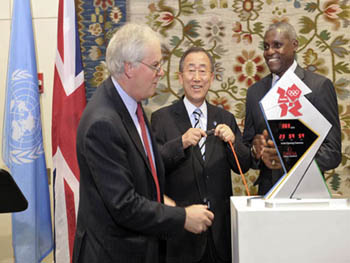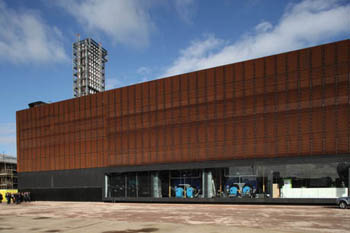UN secretary-general Ban Ki-moon yesterday switched on a one-year countdown clock for the 2012 Olympic Games in London at UN’s headquarters in New York, along with famous Olympian Carl Lewis to mark the Games’ focus on lowering its carbon footprint.
Ban connected wires to start the clock, a smaller replica of the futuristic clock in Trafalgar Square that is keyed to the opening ceremonies in London on the evening of 27 July 2012.
“As we all know, sustainability is the capacity to endure, as all Olympic athletes must do. Here at the United Nations, it is the necessity to co-exist harmoniously with our natural world,” said Ban yesterday.
He spoke to Lewis, who, in his athletic career won 10 Olympic medals – nine of them gold – and who the international Olympic Committee named as ‘Sportsman of the Century’ in 1991.

UN secretary-general Ban Ki-moon (centre), plugs in the United Nations countdown clock that will tick away until he start of the Olympic Games in London on 27 July 2012. Also pictured is UK Ambassador Mark Lyall Grant (left) and former Olympian Carl Lewis. Image courtesy of UN
Yesterday, Ban thanked Lewis for his contribution to sport and to the UN.
“You are the hero. Everybody knows your Olympic days. I was one of your fans. You were the hero in the Seoul Olympic Games in 1988, winning all the medals. Now you have another, different kind of face as a UN Goodwill Ambassador for FAO, the Food and Agriculture Organization. For a person like you, for a star like you, for a celebrity like you, you help put a human face on our daily work – this is an immense contribution for humanity, and I really thank you for your contribution.
On the Olympic Games in London, Ban finished by welcoming its focus on clean energy and eco-friendly development.
The green build
The London Olympics organising committee has pledged to attempt to make the Games environmentally friendly by minimising greenhouse gas emissions, waste, and the impact of the event on local wildlife.
Working closely with the construction industry, some of the committee’s goals include creating venues, facilities and infrastructure that will leave a lasting environmental and social legacy for London. It says the remediation of the site will bring existing land back into public use and create “significant improvements for the quantity and quality of green space” in east London.
Construction of the Olympic Park is now almost 88pc complete.

Energy Centre in the Olympics Park in London, which uses clean technologies
The Energy Centre will provide power, heating and cooling across the park for the Games, and for the new communities and buildings that will develop after 2012.
The centre has a biomass boiler that will use woodchip to generate heat, as well as a natural gas-powered combined cooling heat and power plant (CCHP).
The committee is also creating 100 hectares of green spaces, which will be designed to minimise flooding in the river valley and “enrich the biodiversity of the Lower Sea Valley”.
The committee has contracted a waste management company to sort, compact and transport waste from the site – of which it says 90pc will be recycled or reused.
Back in April, the committee released its first full sustainability report – A Blueprint for Change.
Main photo: An aerial image of the Olympics Stadium in London, taken to mark the one-year countdown to the London Olympics yesterday